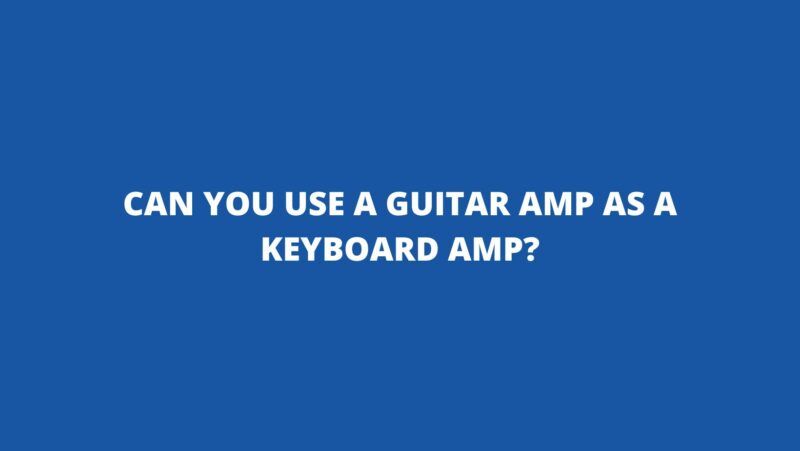In the world of music, boundaries are often meant to be pushed, leading to innovative approaches that challenge conventional norms. One such exploration involves using a guitar amplifier to amplify a keyboard. This unconventional practice has garnered attention for its potential to create unique sonic textures and broaden the creative horizons of musicians. This article delves into the possibilities, considerations, and potential outcomes of using a guitar amp as a keyboard amp.
Understanding Guitar Amplifiers:
Guitar amplifiers are revered for their ability to shape the tonal characteristics of electric guitars, emphasizing their distinct nuances and effects. These amplifiers are engineered to accentuate the midrange frequencies that define the guitar’s sonic signature. They often feature tone controls, overdrive/distortion channels, and effects loops, which are optimized for guitarists to sculpt their desired sound.
Expanding the Use of Guitar Amps:
The practice of using a guitar amp for a keyboard, while unconventional, has gained popularity among musicians seeking to explore new sonic territories. Keyboards, which encompass digital pianos, synthesizers, and MIDI controllers, offer a diverse range of sounds that can benefit from the coloration and effects options of a guitar amplifier.
Benefits of Using a Guitar Amp for Keyboards:
1. Unique Sonic Coloration: Guitar amplifiers impart a distinctive sonic coloration to the signals they amplify. When applied to keyboards, this coloration can create new, intriguing tonal textures that might not be achievable with dedicated keyboard amplifiers. Musicians interested in sonic experimentation can leverage this unique quality to create unconventional sounds.
2. Creative Effects Application: Guitar amps often come with built-in effects like reverb, delay, and modulation. Keyboard players can take advantage of these effects to add depth and character to their sounds. This opens up avenues for creative soundscapes and innovative compositions.
3. Distortion and Overdrive: Certain genres call for distortion and overdrive effects that are commonly associated with electric guitars. Using a guitar amp for keyboards allows musicians to apply these effects to their keyboard sounds, offering an alternative approach to genre-specific tonal characteristics.
4. Sonic Fusion: Combining the tonal qualities of a keyboard with the coloration of a guitar amp can lead to a fusion of sounds that blur the lines between different instruments. This can create a signature sound that is entirely unique to the musician.
Considerations and Limitations:
While the practice of using a guitar amp for keyboards offers exciting possibilities, it’s essential to consider the limitations and potential challenges:
1. Frequency Range: Guitar amps are engineered to emphasize midrange frequencies, which may not fully capture the broad frequency range of keyboards. Bass and treble frequencies might be less pronounced when using a guitar amp, leading to a tonal imbalance.
2. Clean Reproduction: Keyboards often require clean, faithful sound reproduction across various frequency ranges. Some guitar amps might struggle to accurately reproduce keyboard sounds, particularly at higher volumes.
3. Effects Integration: While guitar amps offer effects, they might not be optimized for the diverse range of effects that keyboards require. Compatibility issues and limited control options could arise when connecting keyboards to guitar amplifiers.
4. Speaker Configuration: Guitar amps are designed with specific speaker configurations tailored to the sonic characteristics of guitars. Keyboards might benefit from a full-range speaker setup to accurately reproduce their sounds. Using a guitar amp with a limited speaker configuration might compromise the overall sonic integrity.
Conclusion:
Using a guitar amplifier to amplify a keyboard is a practice that blurs the boundaries between different instruments and their amplification solutions. While unconventional, this approach offers musicians a chance to experiment with unique sonic textures, creative effects, and genre-crossing tonal qualities. The possibilities of fusing keyboard sounds with the coloration of a guitar amp can lead to innovative compositions and soundscapes that break away from traditional norms.
However, it’s crucial to approach this practice with a clear understanding of the potential challenges and limitations. The tonal characteristics, frequency range, effects compatibility, and speaker configuration of both the guitar amp and the keyboard must be carefully considered. Musicians seeking to explore this avenue should view it as a creative experiment, ready to embrace the unexpected outcomes that arise from blending two distinct sonic worlds.
Ultimately, the decision to use a guitar amp as a keyboard amp depends on the musician’s creative goals, willingness to embrace sonic experimentation, and the ability to adapt to the unique qualities that this unconventional approach can bring to their musical journey.


